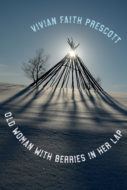 Vivian Faith Prescott
Vivian Faith Prescott
Old Woman with Berries in Her Lap
University of Alaska Press
Reviewer: Vivian Wagner
Vivian Faith Prescott’s Old Woman with Berries in Her Lap is a collection of poems about colonialism, survival, and the reclaiming of lost cultural identity. These poems explore the Sámi diaspora and one descendant’s desire to discover, re-narrate, and bring back to life fragments of a half-remembered past in a yet-more-fractured present. The moving and extraordinary poems in this collection traverse a space between past and present, myth and reality, loss and abundance.
Set against a backdrop of the complex and often fraught history of Sámi reindeer herders brought from Scandinavia to Alaska in the late nineteenth century, these poems use language, images, and storytelling to heal generational trauma, to re-envision lost cultural identity, and to move with compassion and awareness into an uncertain future.
The collection opens with the following epigraph:
Sámi Riddle: What is an old woman with berries in her lap?
Answer: A well-traveled lavvu with a fire in the center.
This riddle captures a theme that runs throughout this collection: the idea that homes can and must be continually recreated. A lavvu is a traditional Sámi dwelling, and the fire in the center represents warmth, culture, and survival. Similarly, an old woman with berries in her lap creates a nurturing, life-giving space. These poems themselves serve a similar function: to make space for survival, to fan the flame of life.
The opening poem in the collection, “Our tents are small volcanoes,” echoes that image of the lavvu with a fire at the center: “The center of our cosmos moves, our fire falls inward, / our boats are filled to the brim, ready to migrate again.” At the same time, it conjures a parallel narrative of a woman in a modern-day supermarket: “the rusty grocery cart clunks down the aisle. / Inside it, my baby sleeps in her yellow plastic cradle.”
We learn of the speaker’s inability to afford to buy food for her hungry baby, as she crosses things off her list that she hasn’t yet put in her cart: “most things.” In the midst of her desperation, however, she finds solace and strength in her Sámi heritage, with its deep knowledge of nomadic survival. The two narratives, past and present, begin to merge, giving her the resilience she needs to go on: “the boxed cereal tumbles from the shelf. And I brush / willow branches aside. My baby cradles atop the reindeer pack. / In the distance I see gold firelight inside the tents.”
The fire in those tents—though almost entirely imagined—is what she needs in this moment to survive. It’s a story that keeps her going: “my baby is hungry and I search the horizon for small volcanoes.”
Colonialism and post-colonialism play a large role in this collection, which seeks to uncover a cultural identity that’s been lost primarily as a result of being erased. “In the Age of Print,” for example, opens as follows:
We entered the European consciousness
like frost furrowing deep
into silence—
a shrine of wind.
Not long after that meeting of cultures, Sámi culture found itself threatened:
Everything was claimed and taxed:
three reindeer skins per Sámi.
We were portrayed and researched,
studied and framed.
The poem ends, though, with a defiant sentiment: “Open your eyes now. / There are ghosts in every direction.” These ghosts won’t let the trauma wrought by colonialism rest; there needs to be a reckoning, and these poems offer at least the beginning of one.
Other poems, like “Drawing Blanks,” playfully explore assumptions about Sámi people and culture. The “blanks” in this poem remain to be filled in: “All Saami love reindeer because________________,” for instance. Or “If you don’t know how to yoik you are _____________________.” Literally, these blanks beg a variety of questions, leaving open spaces for reconsideration, retelling, and resistance to dominant narratives.
Similarly, “Check the Box” looks at the restrictive categories of race and identity within American culture, exposing the limitations of these categories and attempting to create new ones. The choices for answering the query “Which traditional garments do you wear?,” for instance, include reindeer moccasins and gákti alongside Carhartts. And the question “Do you sing weird songs without words in the woods?” is followed by “Does your blood contain mtDNA subhaplogroup U5b?” Together, these questions and their boundary-pressing answers throw into relief various assumptions about identity, genetics, and race.
Claiming identity, even when that identity is fractured and partially unknowable, is a central theme in many of these poems. “How to say IT,” for example, explores Sámi culture in the context of claiming identity: “Say it sloooooooow. Sámi. Say it with your breath. And when IT comes out of your mouth, know this is the first time. Of many times …. Write it. Decolonize it.”
Many of the poems in the collection draw on and are titled after North Sámi terms for types of snow and ice, features in the landscape, and natural phenomena. In so doing, they serve both as a kind of language lesson and an exploration of the role of language in creating a sense of identity and culture.
Often, the titles of these poems themselves are essentially poems: as in “Suovdnji—Hole in the snow where ptarmigan hide; grazing hole dug by reindeer; hole dug by humans when melting snow or to shelter from a storm.” In this poem, we hear about Sámi drums in a museum, hiding like ptarmigan in the snow, and coming back to life in the poem itself: “But our drums, once forbidden, / sleep / in museums’ glass cases.” Similarly, in “Moarri—Thin ice crest that breaks and cuts the hoofs of horses and reindeers,” the speaker, too, slips through “thinning ice,” discovering “How to listen to the pulse / beneath my own skin.”
Ultimately, these poems are powerfully hopeful, understanding both the depth of the world that’s been lost and the power of language, poetry, and story to recreate it. In the last poem of the collection, “Remedy for Assimilation,” the speaker calls forth images from Sámi culture that serve as a kind of antidote to erasure: “Press a bear’s tooth or reindeer jawbone / on the affected area of the tooth. Learn // to pull poems from your bones.”
There’s power in pulling poems from bones, and Prescott’s collection does just that, even as it recreates a lost story “to be told to outsiders.” These poems aren’t just about recovering a lost past, but about recreating that past, and about using newly-fashioned words, songs, and stories to make space for a yet-to-be-imagined future.

